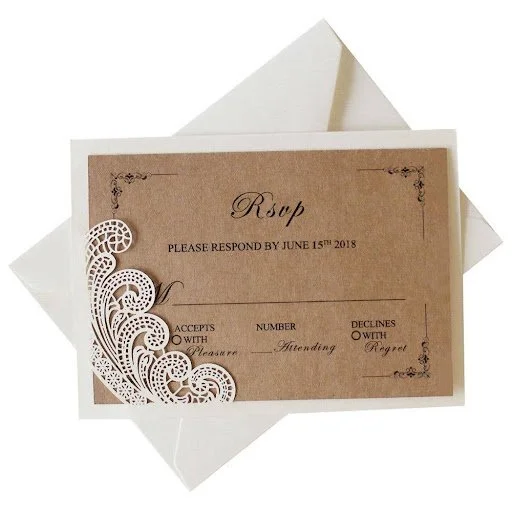Ceremony & Traditions
Aisle Runner – A decorative strip (fabric or synthetic) placed along the aisle for the wedding procession.
Processional & Recessional – The order in which the wedding party and couple enter and exit the ceremony.
Unity Ceremony – A symbolic act (e.g., lighting a candle, pouring sand) representing the couple’s union.
Vow Exchange – The moment when couples share their promises during the ceremony.
First Look – A private moment where the couple sees each other before the ceremony.
Receiving Line – A formal way for the couple to greet and thank guests after the ceremony.
Officiant – The person who legally performs and leads the wedding ceremony.
Marriage License vs. Marriage Certificate – A license allows a couple to marry; a certificate proves the marriage happened.
Toss Bouquet – A smaller bouquet designed for the bouquet toss tradition.
Golden Hour – The period right before sunset, known for stunning photography lighting.
Wedding Party & Attire
Bridal Party vs. Wedding Party – The bridal party includes bridesmaids, while the wedding party includes everyone (bridesmaids, groomsmen, etc.).
Maid of Honor vs. Matron of Honor – The Maid of Honor is unmarried; the Matron of Honor is married.
Boutonnière – A small floral arrangement worn by the groom, groomsmen, or other important guests.
Corsage – A floral arrangement typically worn by mothers and grandmothers.
Garter Toss – A tradition where the groom removes and tosses the bride’s garter.
Dress Code (Black Tie, Semi-Formal, Cocktail, Casual) – Different levels of attire expectations for guests.
Black Tie – Requires tuxedos and floor-length gowns.
Formal – Suits and elegant dresses are appropriate.
Cocktail – Men wear suits; women opt for knee-length dresses.
Semi-Formal – Dress pants, button-down shirts, and stylish dresses.
Casual – Sundresses, slacks, and relaxed attire, ideal for outdoor weddings.
Reception & Venue Logistics
Cocktail Hour – The period between the ceremony and reception where drinks and appetizers are served.
Grand Entrance – The formal introduction of the couple and wedding party at the reception.
Head Table vs. Sweetheart Table – The head table seats the couple and wedding party, while the sweetheart table is just for the couple.
Escort Cards vs. Place Cards – Escort cards direct guests to their table; place cards designate specific seats.
Floor Plan – A layout of the event space showing where tables, chairs, and dance floors will be placed.
Tablescape – The decorative arrangement of a table setting, including florals, linens, and dinnerware.
Uplighting – Lighting placed at ground level to create a dramatic ambiance.
Corkage Fee – A venue charge for bringing your own alcohol.
Service Charge vs. Gratuity – A service charge is a mandatory fee; gratuity is optional but expected for excellent service.
Open Bar vs. Cash Bar vs. Limited Bar – Different ways to handle alcoholic drinks at a wedding.
Open Bar – The couple covers all drink costs for guests.
Cash Bar – Guests pay for their own drinks.
Limited Bar – Select drinks (beer, wine, or signature cocktails) are covered, while guests pay for extras.
Vendors & Planning Terms
Day-of Coordinator vs. Wedding Planner vs. Venue Coordinator – Different roles in wedding management; a planner oversees everything, a venue coordinator handles venue logistics, and a day-of coordinator ensures smooth execution on the wedding day.
Save-the-Dates vs. Invitations vs. RSVP Cards – Save-the-dates inform guests early; invitations are formal requests to attend; RSVP cards collect guest responses.
Wedding Favors – Small gifts given to guests as a thank-you.
Calligraphy vs. Digital Printing – Different styles of invitation lettering. Calligraphy is hand-written, digital printing is computer-designed and printed.
High-Touch vs. All-Inclusive Venue – High-touch means customized services; all-inclusive provides pre-packaged services.
Rain Plan/Backup Plan – The venue’s contingency plan for bad weather.
Guest Count vs. Guaranteed Guest Count – The guest count is an estimate; the guaranteed count is the final number given to vendors.
Entertainment & Extra Elements
Live Band vs. DJ – A live band provides music with instruments, while a DJ plays recorded music.
Grand Exit (Send-Off) – The couple’s farewell moment, often featuring sparklers, confetti, or bubbles.
Signature Cocktails – Custom drinks named after the couple or something meaningful.
Photo Booth vs. Live Painter – A photo booth provides instant pictures for guests; a live painter creates a custom painting of the wedding scene.
Guestbook Alternatives – Creative options beyond a traditional book, like a signed photo or audio guestbook.
First Dance vs. Parent Dances – The first dance is for the couple, while parent dances involve a dance with parents.
After-Party – A late-night celebration following the reception, often at another location.




